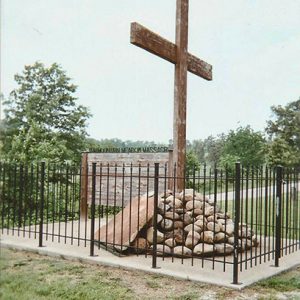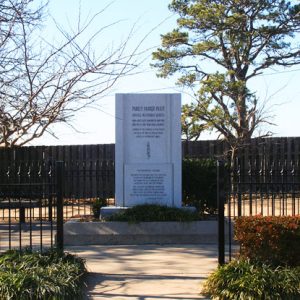calsfoundation@cals.org
Mountain Meadows Massacre
In April 1857, near Harrison (Boone County), 120 to 150 settlers, mostly Arkansans, started a journey toward the promise of a better life in California. Before they could reach their destination, a party of Mormons and Indians attacked them while they camped on a plateau known as Mountain Meadows in southern Utah. All of the travelers died except for seventeen children, who were taken into Mormon homes.
Beyond this information, little can be agreed upon, from the number of victims to who was responsible. About forty families, composed mainly of Arkansans from Marion, Crawford, Carroll, and Johnson counties, met at Beller’s Stand just south of Harrison. This migration was known by several names, including the Baker train and the Perkins train, but it became known as the Fancher train (or the Baker-Fancher train) after combining in Utah. Fancher, commonly known as Captain Fancher, from Carroll County, had made the trek to California twice before, and historians speculate that he might have led the trains after they came together. The exact number of emigrants remains in doubt because at least a few people from surrounding states joined the Arkansans, as did settlers along the trail.
The party made its way into Utah Territory in July and split into two trains, with the Fancher train pursuing a southern route. The Mormons did not receive the travelers hospitably, refusing to trade with them. The poor reception was based partly on an advancement of the United States Army toward Utah and partly on the death of a Mormon leader a few months before in Arkansas. The travelers found some relief when they reached Mountain Meadows. This area consisted of the southern rim of the Great Basin and was covered with fresh grass and plenty of water. On September 7, the party came under attack by a group of Indians and Mormons dressed as Indians. Fancher’s people created a strong defensive position by tipping over their wagons and digging firing pits. The attackers besieged the Arkansans for five days, by which time the party had run short of supplies, food, and ammunition.
On September 11, the party thought it had survived when the Mormons approached and made an offer: if the travelers would leave their belongings and weapons behind for the Indians, the Mormons would escort them safely back to Cedar City, Utah. The deal was not particularly favorable, but the settlers had little choice. The party started walking back to Cedar City, given only enough wagons to carry those injured in the attack. Before long, members of the party started to spread out and became isolated from one another. A little more than a mile into the journey, the Mormons turned on the party. They first killed the men, then the women and any children old enough to report the event; the children who were spared were brought to live in Mormon homes. Many who saw the field soon after the massacre insisted that the bodies had been left unburied and were scavenged by wild animals, though a militia detachment later buried the corpses in shallow graves.
Out of fear of retribution, the Mormon Church tried to cover up the crime, mostly by blaming the Indians. The U.S. Army found remains of the victims exhumed by animals, and this, in addition to pressure from victims’ relatives in Arkansas, forced the government to act. The Army found most of the survivors and returned them to Arkansas, but no one was prosecuted for almost twenty years, when the leader of the massacre, John D. Lee, was put on trial. He was convicted for his role in September 1876 and executed on March 23, 1877.
Controversy surrounds the rest of the story. The biggest mystery is why the Mormons would commit such an act and who was ultimately responsible. Starting in 1950, with the publication of Juanita Brooks’s The Mountain Meadows Massacre, historians have debated these issues. Many historians conclude that the attack was the result of bad timing. The Fancher party decided to cross Utah at the worst possible time. In 1857, the United States had deemed the Mormons enemies and sent an army under General Albert Sidney Johnston to put down the Mormon rebellion. The Mormons, with a history of being violently removed from several previous locations, decided to make a stand in Utah. Brigham Young, territorial governor and leader of the Church, prepared his followers to confront the army. On August 5, he declared martial law, including an order not to trade with non-Mormons.
In addition to the hostile attitude already prevailing, stories circulated around the time of the massacre that the wagon train retaliated against the Mormons for their lack of assistance by such acts as poisoning wells. No conclusive evidence of such acts exists, and considerable evidence refutes them. Some recently have suggested that the Mormon Church fabricated stories of misdeeds by the Fancher party after the fact as part of a larger cover-up, though such stories were believed at the time.
Another reason the Mormons may have resented the Fancher party was that it had its roots in Arkansas. Shortly after the wagon train left Beller’s Stand, Parley P. Pratt, a beloved Mormon leader and one of their twelve apostles, was murdered in another part of the state. Several years before, Pratt had converted a woman named Eleanor McLean to the Church. When she left her husband to join the Mormons in Utah, her husband, Hector McLean, began to harass Pratt as he went about his missionary work. Pratt was in New York preaching and Eleanor in New Orleans visiting family. The two decided to meet in May at Fort Smith (Sebastian County) and travel back to Utah together. Hector McLean heard of their intended rendezvous and beat them to Arkansas, where he filed charges against them and got warrants for their arrests. When Pratt and Eleanor McLean arrived, they were arrested and put on trial, but on May 13, 1857, the judge quickly dismissed the cases. Realizing that Hector McLean had stirred up a large crowd against the couple, the judge allowed Pratt to escape out the back door of the courthouse. The mob chased Pratt, and when McLean caught him, he stabbed Pratt twice and shot him in the heart. News of the slaying was filtering into Utah as the wagon train from Arkansas arrived.
As for who was to blame for the massacre, most theories involve Young. The argument accepted by the Church of Jesus Christ of Latter-day Saints suggests that the leaders of the Church in southern Utah held a meeting to decide what to do about the Fancher party. Many wanted to destroy the train, but they decided to send a rider to Salt Lake City to ask Young what to do. Young instructed the rider not to attack the party but to get the Arkansans out of Utah as quickly as possible. Before the messenger arrived back in Cedar City, the militia decided to attack the wagons. The Mormons held Lee responsible and excommunicated him, and the state then executed him. The other theory makes Young responsible. It assumes that nothing occurred in Utah without Young’s knowledge and consent. This theory holds that Young ordered the attack and, afterward, set up Lee as a sacrificial lamb in order to cover up his crime.
Today, monuments stand in Harrison and Mountain Meadows in memory of those who died in the massacre. In 1999, an excavation under the monument in Utah found the bodies of twenty-eight of the victims. In 2011, the site of the massacre was designated a National Historic Landmark by the U.S. Department of the Interior.
For additional information:
Bagley, Will. Blood of the Prophets: Brigham Young and the Massacre at Mountain Meadows. Norman: University of Oklahoma Press, 2002.
Bagley, Will, and David L. Bigler. Innocent Blood: Essential Narratives of the Mountain Meadows Massacre. Norman, OK: Arthur H. Clarke, 2008.
Bashore, Melvin L. “‘The Bloodiest Drama Ever Perpetrated on American Soil’: Staging the Mountain Meadows Massacre for Entertainment.” Utah Historical Quarterly 80 (Summer 2012): 258–271.
Briggs, Robert H. “The Mountain Meadows Massacre: An Analytical Narrative Based on Participant Confessions.” Utah Historical Quarterly 74 (Fall 2006): 313–333.
Brooks, Juanita. The Mountain Meadows Massacre. Norman: University of Oklahoma Press, 1991.
Finck, James. “Utah’s Would-Be War.” Ozark Historical Review 34 (Spring 2005): 18–31.
Garr, Arnold K., Donald Q. Cannon, and Richard O. Cowan, eds. Encyclopedia of Latter-day Saint History. Salt Lake City: Deseret Book Company, 2000.
Gordon, Sarah Barringer, and Jan Shipps. “Fatal Convergence in the Kingdom of God: The Mountain Meadows Massacre in Arkansas History.” Journal of the Early Republic 37 (Summer 2017): 307–347.
Johnson, Janiece. Convicting the Mormons: The Mountain Meadows Massacre in American Culture. Chapel Hill: University of North Carolina Press, 2023.
———. “In Search of Punishment: Mormon Transgressions and the Mountain Meadows Massacre.” PhD diss., University of Leicester, United Kingdom, 2014. Online at https://figshare.le.ac.uk/articles/thesis/In_search_of_punishment_Mormon_transgressions_and_the_mountain_meadows_massacre/10181279 (accessed October 27, 2023).
Long, Joanie Bean. “Mountain Meadows Massacre of 1857, Johnson County Victims.” The Journal [Johnson County Historical Society] 47 (Fall 2021): 40–54.
Mountain Meadows Association. http://www.mtn-meadows-assoc.com (accessed July 6, 2023).
Novak, Shannon. House of Mourning: A Biocultural History of the Mountain Meadows Massacre. Salt Lake City: University of Utah Press, 2008.
Turley, Richard E., Jr. “Lessons We Can Learn from the Mountain Meadows Massacre.” BYU Studies Quarterly 63.2 (2024): 129–137. Online at https://scholarsarchive.byu.edu/byusq/vol63/iss2/7/ (accessed August 9, 2024).
Turley, Richard E., Jr. and Barbara Jones Brown. Vengeance Is Mine: The Mountain Meadows Massacre and Its Aftermath. New York: Oxford University Press, 2023.
Turley, Richard E., Jr. and Eric C. Olsen. “Fame Meets Infamy: The Powell Survey and Mountain Meadows Participants, 1870–1873.” Utah Historical Quarterly 81 (Winter 2013): 4–24.
Turley, Richard E., Jr., Janiece L. Johnson, and LeJean Purcell Carruth, eds. Mountain Meadows Massacre: Collected Legal Papers, Selected Trial Records and Aftermath. 2 vols. Norman: University of Oklahoma Press, 2017.
Walker, Ronald W., Richard E. Turley, and Glen M. Leonard. Massacre at Mountain Meadows. New York: Oxford University Press, 2008.
Wetherington, Ronald K., and Frances Levine, eds. Battles and Massacres on the Southwestern Frontier: Historical and Archaeological Perspectives. Norman: University of Oklahoma Press, 2014.
James Finck
University of Arkansas, Fayetteville











William Campbell Beller Sr. (1799-1850) was my great-great-great-grandfather; my mother’s name was Dorothy Lulabele Beller. I have been involved in studies concerning the Mountain Meadows Massacre for over thirty-two years now and am in the midst of writing a historical novel titled The First 9/11 in America as experienced and seen through the lives of Melissa Ann and David William Beller. I have been to the Beller’s Stand area and have stood at the grave of my great-great-great-grandparents at the Beller-Jenkins Cemetery. I’m planning on revisiting in May of 2017. I also plan to visit the Elmwood Cemetery and elsewhere at that time. I have deep feelings for the Crooked Creek area and the site of the massacre. We have also been to the massacre site and plan to return there again soon. My wife and I lived at Lakeview, Arkansas from 2001 to 2014, during which time we continued our research.